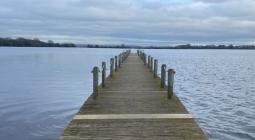Over 11 gruesome kilometres, teams fill bag after bag of marine life killed by SA’s stubborn algal bloom
As council workers collect up to 200kg of dead marine life a day, experts warn the disaster could take a mental toll on the community
The circling, squawking gulls show where the bodies are buried.
Early on a cold winter’s day, mucky foam and seaweed cover the sand at Grange beach – and the dead fish and leafy sea dragons.
Every morning, council workers clear out the carnage left by the algal bloom killing South Australian marine life and causing “collective trauma” in the community.
Over 11km of coast from Grange to West beach, teams from the City of Charles Sturt fill bags with dead fish and animals that will end up as compost, collecting between 40kg and 200kg in a single day.
They arrive before dawn and the daily walkers and their dogs, working to make the afflicted beaches more pleasant. Sometimes, community members make life easier in turn by taking it upon themselves to sort the carcasses into neat piles for them to collect.
“We started doing it because we felt we needed to just get it off the beach,” the coordinator of parks and biodiversity, Tyron Bennetts, says. As the scale of the bloom became clear, they started cataloguing and weighing what they picked up each day.
SA’s algal bloom probably started in January and, over months, has grown to more than 4,500 sq km. By March, surfers complained of a mysterious sea foam, along with irritated eyes and hacking coughs. The algae species responsible was identified as Karenia mikimotoi.
By July it had hit metropolitan beaches: suddenly many more people were witnessing the foam, the piles of seaweed as kelp died off and the animal deaths.
Karenia mikimotoi is not toxic to humans, although it can cause eye, nose and throat irritation. But it has proved catastrophic for fish and marine animals. The iNaturalist site has logged about 34,000 dead animals from about 480 different species.
“We don’t see it stopping anytime soon,” Bennetts says. Satellite imagery has shown the bloom continuing to “pulsate”, dashing hopes that winter would see it off.
Charles Sturt and other local councils will share in funding clean-up operations through a joint state and federal $28m package.
Bennetts’ team rotates clean-up duty to give people a break from the grim pickings.
“It would be a bit much to keep collecting the dead marine life,” he says.
“It’s been a difficult time for everyone – particularly the community – but the team have handled themselves extremely well given the circumstances.
“There has been some pretty distraught community members. We’ve encouraged the team to have the conversation with them, see how they’re feeling.”
The death toll may be limited to marine life but the human mental health toll is building. Dr Brianna Le Busque, an environmental science and psychology researcher from the University of South Australia, has surveyed about 650 people to study the “ecoanxiety” caused by the bloom.
She and fellow researcher professor Carla Litchfield are still analysing the data. But she says they have witnessed people’s extreme anxiety about “seeing the fish wash up on their beloved beaches”.
“One person in particular said it was like seeing the death of a loved one,” she says.
And there’s a double whammy.
“A lot of people go surfing, go for a walk, go diving or fishing as a way of minimising distress,” Le Busque says – but now, the beach is the thing that distresses them.
A parliamentary inquiry into the algal bloom, its causes, impacts and management, is due to report in October. In its submission, the Australian Red Cross notes that the bloom is “not easy or simple to categorise in ‘disaster’ terminology”.
“It has elements of a protracted or slow-onset disaster (no defined start or end, uncertainty around scale, scope, response, declaration and impact),” its submission says. “It has elements of a collective trauma event (public witnessing of death and harm, high horror element, media exposure).”
The Red Cross notes the climate-induced event “bears some resemblance to an agricultural disaster or disease outbreak”.
It says if the psychosocial effects go unaddressed, that could amplify and prolong the harm, and recommends necessary investment to “facilitate a fast and just recovery”.
The science says the bloom was caused by an ongoing marine heatwave, a phenomenon likely to become more common with global heating, as well as nutrients in the water from the 2022-23 Murray-Darling Basin floods and an “upwelling” of colder water towards the surface. But there are still many unknowns.
John Hulmes, part of the council’s beach maintenance crew, talks about the bloom’s unpredictability, of not knowing what will wash up, how much and where.
“When we first started, doing weekend work, we were pretty much only getting Port Jackson sharks and rays,” Hulmes says. “Then you started getting smaller fish …”
The philosophy of the council workers is “if you know the information, give the information”, says the beach, biodiversity and mowing group leader, Evan Woods.
“If you don’t know the information, say you don’t know … but we can endeavour to find out.”
One silver lining in the crisis, Le Busque says, is the community response in the face of “practical anxiety”.
Ecologist Faith Coleman, who has become a leading voice on the bloom, agrees. Her submission to the inquiry says while state and governments have been slow to respond, the community has given her hope.
“The socioeconomic impacts of this bloom have been extensive; however, the community’s response to this bloom has been heartening,” she says.
“Individual and community concern regarding the impacts on our precious marine ecosystems, along with our community’s willingness to learn and change in an attempt to protect this key aspect of SA’s identity and sense of self, has given me hope that there is the political will and willingness to address the twin [crises] of climate change and biodiversity loss, at a state and national level.”
Amid the cold, foam and gathering clouds, Grange local Jackson Miller is one of the few braving the water. He and friend Charlton Gunn are sanguine, both about the bloom and the temperature.
“It’s just beautiful to start the day with something challenging,” Miller says.
Cover photo: City of Charles Sturt beach maintenance worker John Hulmes cleans up dead and dying sea creatures at Grange beach in South Australia. Photograph: Tracey Nearmy/The Guardian




